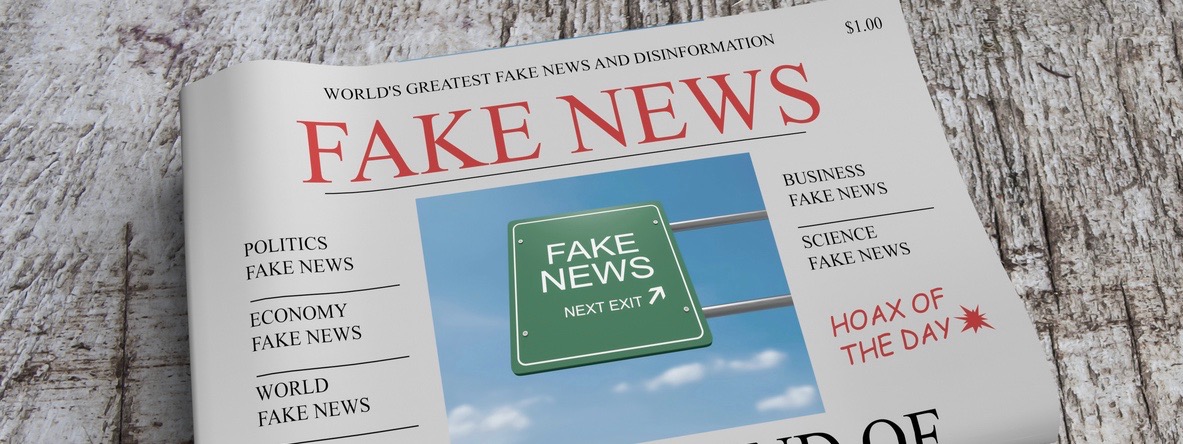Picture this: You are a news publisher, and you work very hard to research, write and publish a story. You have backed up your story with all the relevant data because you want to give your reader an authentic, fact-checked, unbiased news to read and refer to.
But a couple of days later, you notice some other website (a news curator maybe) has manipulated your story, given it an entirely different direction to favor someone in particular. This website champions distribution and within hours the story is out there on every platform—people are reading it, sharing it and believing it. Thus begins a war between Real News and Fake News.
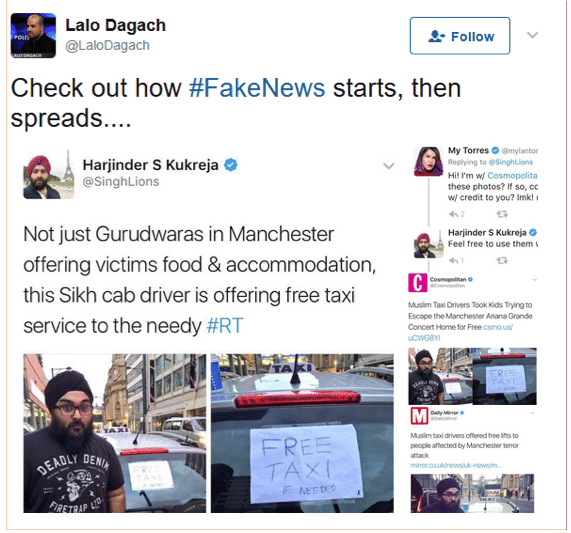
The concept of ‘Fake News’ isn’t new at all. I’m sure we’ve all consumed fake news on the web and would have even shared this news without even batting an eyelid. Let’s admit, we all have done it.
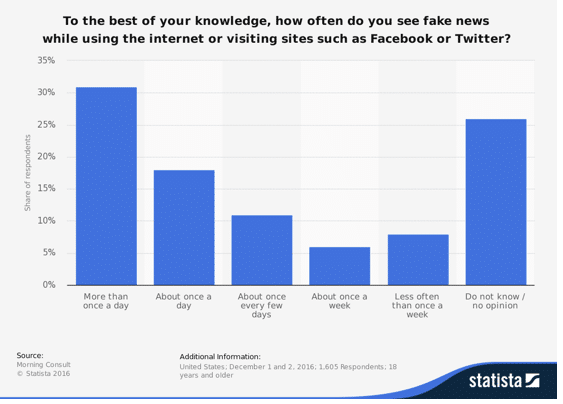
Source: http://guides.wpunj.edu/c.php?g=364911&p=4393456
How can we define fake news?
Fake news is everything from a partial truth to misinformation to outright lying. Every news that isn’t completely true or have undergone some fabrication to favor (or maybe damage) someone’s public image can be considered as a fake news. The very first recorded incident of using fake news goes back to Rome in 1522, where Pietro Aretino tried to manipulate the pontifical election by writing wicked sonnets about all the candidates except his favorite one. Fake news is often seeded, distributed and leveraged by authorities to manipulate public opinion. This is yet another challenge faced by news publisher.
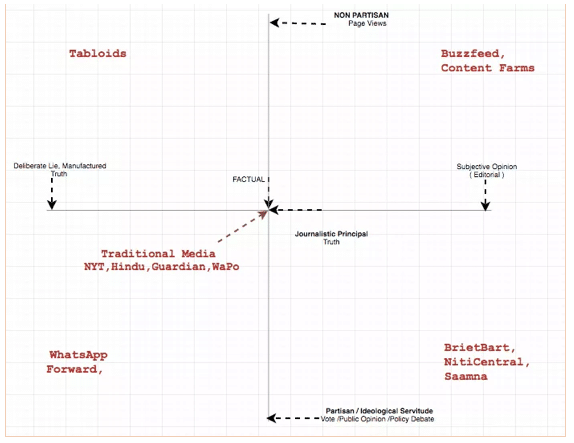
Source: http://www.medianama.com/2017/03/223-anatomy-fake-news/
We read such fake news everywhere on the web, but the most common platforms are involved in the distribution of such news are Facebook, Google, Whatsapp and Twitter. However, they cannot be the blamed for the distribution because, as per the Safe Harbor provision, the platforms are not responsible but for the content hosted on them.
In most of the cases people stay completely unaware about the news being completely fake (or fabrication to a certain extent) as the trust factor upon the platform that we are reading it on surpasses the scope of suspicion towards the same. Over the past decades, the preferred source of news is moved from traditional news publishers to social media and so is our trust associated with them. In some cases, the impact of a fake news reaches to an extent where it outperforms the real news itself.
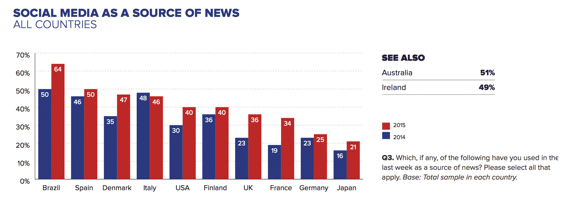
Let me tell you something interesting now .The trust on social platforms is not the only reason that make people trust and share the fake news, trusted share is yet another one. When people see news from a person they trust, they are more likely to think it got the facts right, contains diverse points of view, and is well reported than if the same article is shared by someone they are skeptical of. This factor is not only limited to the possibility of the news being shared, but also makes or breaks the ability of a news to change people’s opinion.
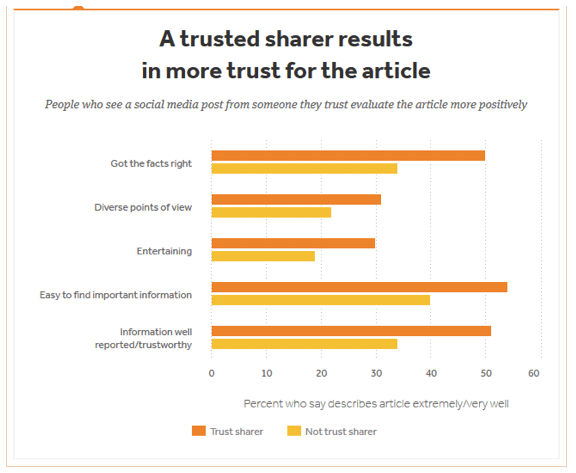
Source: https://www.americanpressinstitute.org/publications/reports/survey-research/trust-social-media/
The five types of fake news
Stories classified as fake news can generally be put into five categories, as experts try to develop a way of warning readers what they may be encountering.
1. Intentionally deceptive
These are news stories created entirely to deceive readers. The 2016 US election was rife with examples claiming that “x celebrity has endorsed Donald Trump”, when that was not the case.
2. Jokes taken at face value
Humour sites such as the Onion or Daily Mash present fake news stories in order to satirise the media. Issues can arise when readers see the story out of context and share it with others.
3. Large-scale hoaxes
Deceptions that are then reported in good faith by reputable news sources. A recent example would be the story that the founder of Corona beer made everyone in his home village a millionaire in his will.
4. Slanted reporting of real facts
Selectively-chosen but truthful elements of a story put together to serve an agenda. One of the most prevalent examples of this is the PR-driven science or nutrition story, such as ‘x thing you thought was unhealthy is actually good for you’.
5. Stories where the ‘truth’ is contentious
On issues where ideologies or opinions clash—for example, territorial conflicts—there is sometimes no established baseline for truth. Reporters may be unconsciously partisan, or perceived as such.
Reference: Deception Detection for News, University of Western Ontario
Where is it coming from—and why
Things got more interesting with the second wave of the Internet. Blogging and self-publishing started a trend which got fueled with the advent of social web and smartphone. Instead of traversing the Internet from webpage to webpage, people started traversing from one person to another. Behavior like Backlinking and Bookmarking got replaced with Follow, Subscribe, Share, Rate and Like. Eyeballs shifted to Facebook, Twitter and WhatsApp. Distribution and creation of content became democratized and more importantly, decentralized. The genie was out of the bottle. Decentralized content creation means a decentralized and diffused responsibility of ensuring authenticity. The stage was set for emergence of Fake News.
While some select publishers and content curators are suspected to have started this for their own good, others (mostly traditional news publishers) are brutally victimized by this challenge. For them the core objective is often to get more traction on their websites.
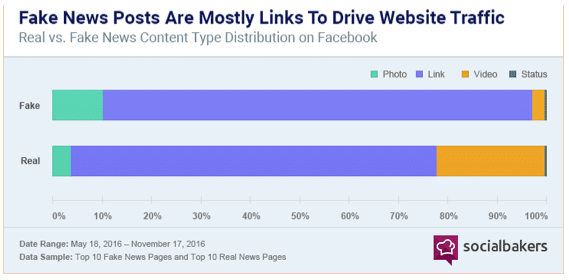
Source: https://www.socialbakers.com/blog/2658-the-fake-news-debate-on-social-who-s-responsible
To our surprise, there are instances where some of the big news aggregators and curators were involved in the fueling up fake news. The core objective for these aggregators is mass distribution of content and they care little about the authenticity of the content being shared Thus often ending up promoting fake news which not only impacts the real news negatively, but also hampers the marketing and PR efforts of any digital news publisher.
Fake news not only impacts your brand image, but also accounts for the overall decline of publishing standards. There are in fact fake News websites which are manufacturing and aggregating news and these websites look like legitimate news sites. And with the increase of such incidents, the airwaves are currently filled with both outrage towards and defense of fake news that has been competing with real news.
However, we certainly cannot and should not put the entire blame on these aggregators as there were even cases when even big brands like CNN, NBC, ABC and The New York Time were accused of spreading fake news. As in a previous event, when President Donald Trump had derided these outlets as sources of “fake news,” charging them with false or unfair coverage. After declaring them “the enemy of the American People” on Twitter, he reiterated the charge on-stage at the Conservative Political Action Conference.


A lot of fake and misleading news stories were shared across social media during the last U.S election. One that got a lot of traffic had this headline: “FBI Agent Suspected In Hillary Email Leaks Found Dead In Apparent Murder-Suicide.” The story is completely false, but it was shared on Facebook over half a million times.
Fake news is the latest culprit of the saga ‘ How Internet Ruined It All’
Yet, we are unlikely to prevail in this battle if we treat the problem of fake news as a creature of the internet—or, for that matter, as a problem unto itself. Fake news is part of a larger problem of “click journalism”—media that focuses on getting online click-throughs, or on “clicking” with our pre-conceived bias,
Can news publishers fight fake news?
You’re probably thinking that there is no way out, but there is definitely a ray of hope for those who are geared up to win. From what we have understood so far, fake news is a huge challenge for authentic traditional publishers and unless they take some definitive steps to fight fake news, the real news is not going to survive. Yes, you read it right – there are some definite steps.
Tangible solutions and actions:
- Make it easier for users to report fake news like facebook allows you to mute accounts and report spam.
- Create a system through which media can send their data about the fact-checking, conformation and reporting on stories. This post quotes some good examples.
- Make the brands behind all the news sources more visible to to users. Maybe a more prominent display of media brands so can they can know and judge the source – for good or bad. It also helps the publishers to be recognized online.
- Highlight the original source of the news.
Some of the researchers even claim that users can be made inoculated towards fake news, the same way it would happen in case of a virus. read this article to understand this further.

In another effort to fight fake news, First Draft is working with Google and Facebook to explore whether they could incorporate code to stop the spread of fake news. Wardle is adamant that tweaking algorithms is not like censorship.
How are social platforms contributing to the problem?
Facebook against fake news
Facebook was criticized for censoring an iconic photo because of nudity, and is now expected to effectively monitor and censor Fake News. Mark Zuckerberg writes:
“The problems here are complex, both technically and philosophically. We believe in giving people a voice, which means erring on the side of letting people share what they want whenever possible. We need to be careful not to discourage sharing of opinions or to mistakenly restrict accurate content. We do not want to be arbiters of truth ourselves, but instead rely on our community and trusted third parties.”
- He also outlines the project’s Facebook has underway to address Fake News and misinformation. More on it here.
- Recently Facebook has also announced the launch fake news filters in Germany. It is said that these filters will allow readers to tag news (fake news) as ‘Fake’ to warn other readers and block them from sharing such news. These tools first started rolling out these tools in the US last December.
- Facebook will also start paying fact checkers to fight fake news. The company said then that it would work with Snopes, Politifact, ABS News and FactCheck.org to identify hoaxes and fake news tagged by users. If found disputed, Facebook would warn users trying to share the story that has been marked as false, stating “independent fact-checkers have disputed its accuracy.”
- Adam Mosseri announced the roll out of yet another media literacy campaign to help users spot fake news and misinformation: “We’re featuring this tool at the top of News Feed for a few days to people on Facebook in 14 countries.”
Google against fake news
Google itself is playing their part in this battle to take fake news down. This April, Google announced changes to its search algorithm in an attempt to push down fake news from its search results. This new update includes more emphasis on authoritative content along with providing a direct feedback forms for users.
This is how giving feedback on inappropriate featured snippet answer works
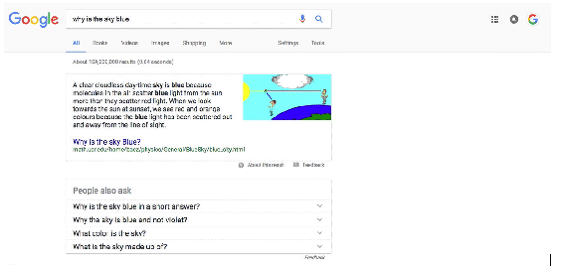
Google also introduced a fact-checking tag on its search results earlier this year.
What can we do as end readers? Suspect and inspect
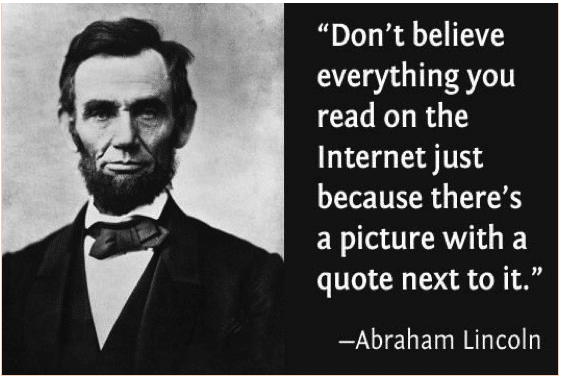
As far as the end reader is concerned, they are also highly responsible for spreading such fake news. We must keep in mind that sharing happens when you’re angry or excited by something, and as long as someone is trying to manipulate your emotions, we don’t have a solution anywhere close by. You share a news mostly when it confirms what you want to believe and you’d want others to believe. It might be about your enemy, your opponent or maybe about someone you desperately want to believe in. Simply put, it’s merely playing with the reader’s psychology. And once the readers have what they wanted, they’ll be more than happy to share it without any further efforts from your end. The readers might not completely believe in the news or understand its implication, but if it’s shared by their friends, they usually tend to share it because it helps them feel recognized in their friend circle.
It’s a vicious cycle—and we must break it. I am not saying readers should always be suspicious of what they are reading, but if there’s a slightest suspicion, they should not completely dismiss it. The best approach here would be doing a basic fact check or maybe just checking the original source of the news before believing it and sharing it with others.

